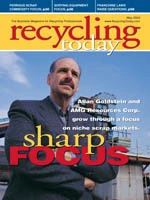FUEL FOR THOUGHT
Recyclers of demolition wood must weigh the options of relying on the biomass fuel market versus some of the other wood recycling options, according to the University of Florida’s Tim Townsend. The C&D recycling researcher spoke to attendees of a session at the National Association of Demolition Contractors (NADC) Annual Convention in Orlando in early April.
Screening out wood with lead-based paint (LBP) and chromated copper arsenate (CCA) are among the issues facing wood recyclers. Both of their leading markets—the wood fuel and mulch markets—will be unwilling to tolerate high levels of either LBP or CCA. Fuel users want to keep their emissions clean, while mulch vendors do not want to risk exposing their customers to contact with the toxins.
Townsend says he does not see any markets for wood supplanting these two leading markets, one of which is regional and the other seasonal.
although in the new construction process there have been contractors who have been grinding their scrap wood on site and using it as mulch and ground cover.
Wood fuel markets can be volatile, with recyclers sometimes dependent on the fortunes of one major regional consumer.
Landfill operators who do not want the unpleasant odors arising from scrap drywall may help spur the gypsum recycling market. Townsend noted that recycling loops for the material have been created in the Pacific Northwest, with scrap drywall used by drywall manufacturers, by Portland cement makers (who can accept up to five percent gypsum content) and by farmers seeking to enrich the calcium content of their soil. At some facilities, the scrap paper portion of scrap drywall is added to compost piles.
Recycled concrete and asphalt markets remain stable in most regions, although these markets could be spurred on if more states begin to develop specifications for using recycled aggregates in highway applications, Townsend noted.
By volume and weight, finding markets for soil and other "fines" remains a priority for C&D recyclers. Some recyclers are marketing their fines as a fill or cover product called recovered screened material (RSM). This product is generally not dense enough to be used as fill for construction applications, said Townsend, although it is acceptable for embankments, berms and as alternative daily landfill cover.
C&D RECYCLER BOOSTS CIRCULATION
C&D Recycler magazine, a publication of the Recycling Today Media Group, Cleveland, has announced a 20 percent boost in the circulation of its bi-monthly magazine.
Effective in January 2003, the magazine’s circulation was increased by 20 percent to 6,000, with a focus on the demolition industry, C&D Recycler sales manager Ed Gallo says.
"During 2002 we performed an analysis to determine the size of the demolition industry throughout the U.S.," says Gallo. "Our studies revealed that there are some 3,747 demolition contractors in the U.S., with many of these being one or two-person operations. We are capturing the higher end of the market and have extended our circulation to now reach 2,349 demolition contractors," he adds.
Gallo also notes that many of the 2,370 C&D recyclers already on the magazine’s circulation list are also demolition contractors, "So we have built a circulation that provides market access to virtually the entire demolition industry."
The circulation boost has occurred in tandem with the launch of the www.cdrecycler.com Web site and the C&D Recycler Update e-newsletter.
Those seeking additional advertising information for C&D Recycler can contact Gallo at (678) 566-7841. Those who wish to subscribe to the print publication can contact the Recycling Today Media Group circulation department at (800) 456-0707, while those wishing to sign up for the e-newsletter can contact Dan Sandoval at dsandoval@cdrecycler.com.
Get curated news on YOUR industry.
Enter your email to receive our newsletters.

Explore the May 2003 Issue
Check out more from this issue and find your next story to read.
Latest from Recycling Today
- Altilium produces EV battery cells using recycled materials
- Brightmark enters subsidiaries of Indiana recycling facility into Chapter 11
- Freepoint Eco-Systems receives $50M loan for plastics recycling facility
- PET thermoform recycling the focus of new NAPCOR white paper
- Steel Dynamics cites favorable conditions in Q1
- Hydro starts up construction in Spain
- Green Cubes unveils forklift battery line
- Rebar association points to trade turmoil





